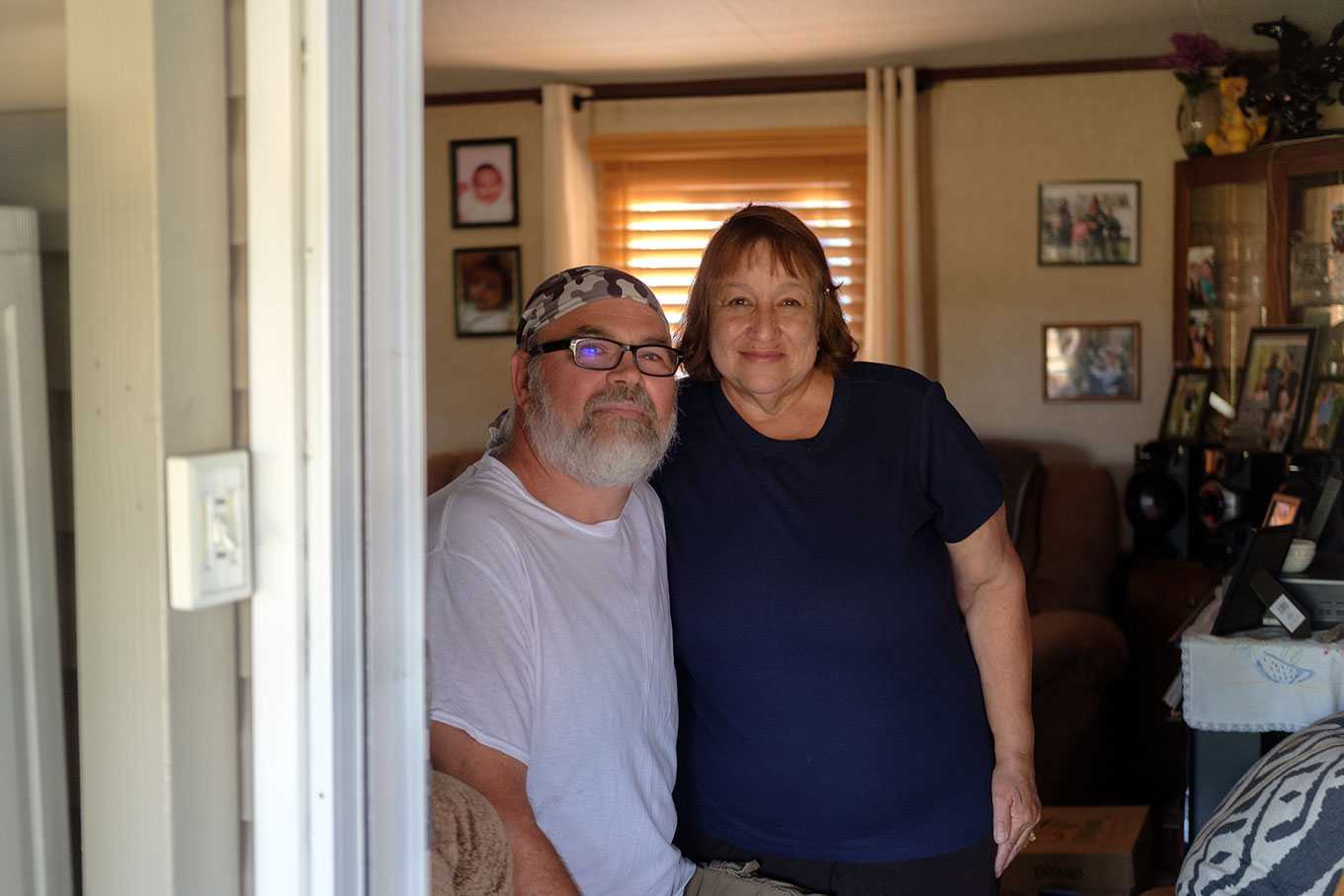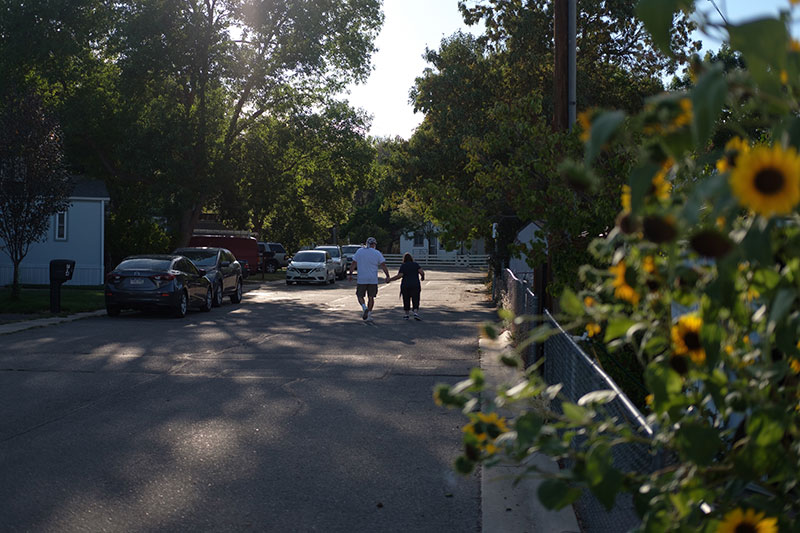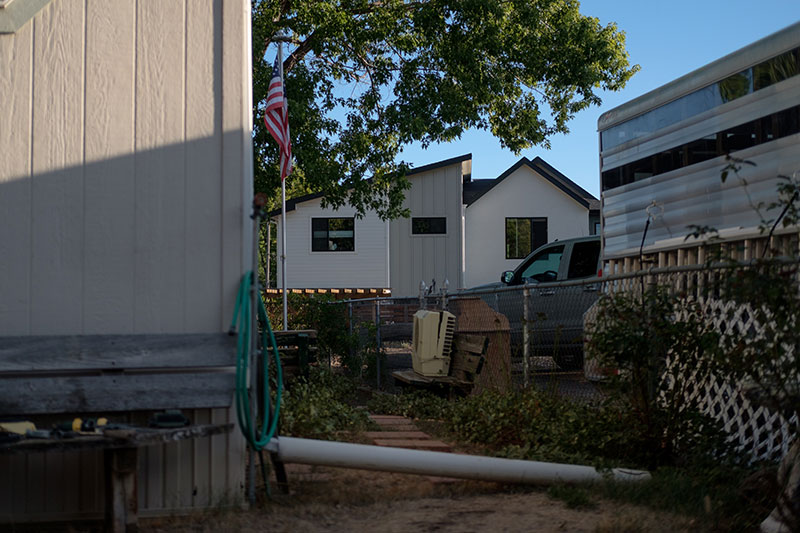Lafayette Residents Rally to Buy Mobile Home Park and Protect Affordable Housing
Leer en español
LaVern and Denise Schafer pose for a portrait in their manufactured home on Monday, Sept. 16, 2024, in the now resident-owned community in Lafayette, Colo. The residents formed the La Luna Community Cooperative to buy the park, formerly known as Mountain View Mobile Home Park. Photo by Eli Imadali / Special to The Colorado Trust
By Saja Hindi
In small print on a white no-trespassing street sign, the text reads, “Mountain View Mobile Home Park.” It’s one of the last remnants of the former ownership of the now-resident-owned community in Lafayette.
Denise Schafer smiled as she glanced at the sign during a mid-September stroll through the neighborhood—renamed La Luna Community Cooperative—with LaVern Schafer, her husband and the co-op board president. The couple recounted stories of raising their two children and caring for their grandchildren in their neighborhood of nearly 40 years, which they now partly own.
“I’m very proud that we purchased it. … It’s a phenomenal thing to happen to us,” Denise Schafer said.
October marked one year since the residents of the 34-home community came together to form La Luna Community Cooperative to buy and manage the land beneath their manufactured homes (also sometimes referred to as mobile homes) in the former coal mining town in southeastern Boulder County. On Jan. 31, it became official: The cooperative purchased the property at the southeast corner of East Cleveland Street and South Burlington Avenue for $4.5 million from former owners Craig and Kent Brown.
“The common people can do the impossible,” LaVern Schafer said of the purchase. “To me, buying the mobile home park was the impossible.”
For the Schafers, the community’s new name also indicates that. Denise said she loves the change to “La Luna,” meaning “the moon” in Spanish because it’s a nod to her heritage and that of others in the neighborhood (about 57% self-identified as Hispanic or Latino in surveys collected during the purchasing process). It also represents what a fellow board member of LaVern Schafer’s said about the co-op’s purchase: If the residents can accomplish it, they will be “over the moon.”

LaVern and Denise Schafer walk on Monday, Sept. 16, 2024, through the La Luna Community Cooperative mobile home park, where they live, in Lafayette, Colo. Photo by Eli Imadali / Special to The Colorado Trust
In typical manufactured home communities, residents own their units but not the land beneath them. The owners control the land, set fees, establish neighborhood rules, and manage utility systems, roads and community landscaping. As the communities are sold to new owners and investors, residents often face market-rate rent increases.
In a resident-owned community (commonly known as a ROC), the cooperative ownership controls costs, meaning residents aren’t subject to rising rents for owners to increase profit margins; they have more eviction protections for homes that are most likely not actually mobile; and they can improve their neighborhood infrastructure and utilities (which tenants throughout the state have reported significant problems with, particularly with corporate ownerships).
People continue to own their units in resident-owned manufactured home communities—some may still be paying mortgages on their homes—and each household owns an equal share of the land for the whole community. They get a perpetual “lease” and pay monthly lot or site fees to the cooperative that are meant to cover costs like property taxes. That doesn’t mean rents won’t ever increase, but they will become more stable over time, according to the nonprofit ROC USA. That’s because the cooperative is focused on paying back its loans and covering operating costs and capital improvements, not on increasing profits.
The residents are not individually liable for the cooperative’s loans and just have to pay back a one-time fee if they move, a member share, which typically ranges between $250 and $500. Among the ROC USA communities, each co-op sets its member share at a maximum of $1,000 per share. If the residents want to sell their homes, they can request that the co-op transfer ownership in the community to the new owners.
Accomplishing ‘the impossible’
Organizations ROC USA and Thistle Community Housing (both are Colorado Trust grantees) guided the La Luna residents through the process and helped them secure the needed funding to become a resident-owned community. The contributions included funding from the City of Lafayette, Boulder County, the Colorado Department of Local Affairs and ROC USA.
ROC USA’s mission is to help mobile home park tenants across the country purchase the land they live on through a cooperative resident-ownership model. Thistle, based in Boulder County, works to develop, manage and preserve affordable housing and serves as a ROC USA technical assistance provider for homeowners.
After changes to Colorado law that made it easier for mobile homeowners to buy their communities’ properties when they go up for sale, ROC USA worked with nine organizations in the state in 2022 to create a financing pool to empower future resident ownership. The Colorado Trust was among those organizations, contributing $5 million to the pool ($625,000 grants each to ROC USA and Thistle and $3.75 million in program-related investments to be paid back at below-market values).
It’s the first time ROC USA has put together this kind of financing pool, said spokesman Mike Bullard, and the organization is looking to replicate it in other states.
That funding mechanism helped manufactured home residents purchase three properties in Colorado in recent years: Paradise Village in Johnstown in October 2022, Golden Hills in Golden in July 2023 and La Luna in Lafayette in January 2024.
Nine manufactured home communities with 451 homes in Colorado have become ROC USA resident-owned communities, according to ROC USA. The process is complicated and wouldn’t have been possible without Thistle’s guidance, LaVern Schafer said.
Two ROCs have since defaulted on their loans, which the nonprofits are working to help resolve by providing them with more resources and support, but none have dissolved or reverted to private ownership. Bullard said the two properties are part of the same cooperative, which he cited as a reason for the financial struggles. He noted that ROC USA no longer finances this model because of the increased challenges associated with it, including with member engagement.
Nearly a year after residents bought the Lafayette mobile home park, LaVern Schafer still beams with pride when he talks about the residents’ efforts to make that ownership a reality.
He recalls how, when he heard the park was going up for sale, he stopped his most recent landscaping project on his cherished vegetable garden and gave up thoughts of future improvements to the Schafers’ manufactured home. Purchased in 2013, it was the second unit the couple had bought to replace the first in the same community. LaVern Schafer also had trouble selling his parents’ mobile home because it was in a park with an uncertain future.
“Every one of us, all 34 units, were in the same boat,” LaVern Schafer said. “[We thought], are we going to be homeless? Where are we going to go?”

LaVern Schafer, president of the La Luna Community Cooperative board, laughs as he shows the backyard and garden of his manufactured home on Monday, Sept. 16, 2024, in Lafayette, Colo. Photo by Eli Imadali / Special to The Colorado Trust
Fear and panic spread through the neighborhood, he said, because the tenants knew that a new owner could either significantly increase rents or an investor could buy the property and turn it into another type of housing development. Additionally, moving manufactured homes is difficult, the lots available along the Front Range are few, and the community’s tenants couldn’t afford to move into another type of housing.
But when they “banded together and pulled together, we were amazed that we could actually pull this off and own the park today,” LaVern Schafer said.
In 2019, Colorado lawmakers passed legislation creating a Mobile Home Park Oversight Program to strengthen protections for mobile home tenants after learning of an increase in out-of-state corporate owners buying the properties and residents suffering from predatory practices, including skyrocketing rent increases and unsafe living conditions from wastewater issues to infrastructure.
A recent Denver7 investigation revealed a years-long backlog in complaints to the state program. That’s partly why some believe the solution is resident ownership. Another reason is preserving affordable housing in a state with rising housing costs.
In 2020, Colorado lawmakers passed a new law giving manufactured homeowners the right to purchase their parks if their landlords put them up for sale, allowing them to match third-party proposals. In 2022, they expanded the legislation to increase how long tenants have to buy the parks and to give them first right of refusal. If landlords change the parks for another use, they must compensate the tenants.
Working with the Browns
These new laws, coupled with Craig and Kent Brown’s desire to sell to the residents, helped La Luna Community Cooperative become a resident-owned community. One of the brothers initially contacted Thistle to discuss the possibility.
The Brown brothers inherited the park from their parents, who bought it in the 1980s. After their dad died and their mom got sick, Kent Brown and his wife moved into his mom’s house to help take care of her, and Craig Brown bought a mobile home in the park. When their mom died, they inherited the business.
For them, it was never about maximizing profits. LaVern Schafer said the brothers charged differing lot rents based on people’s living situations and often covered expenses they didn’t pass on to the residents. Kent Brown said the community had people living in it who were working hard to get by, including older adults, people with disabilities and new immigrants.
The Browns raised rent rarely and only to help pay for infrastructure projects, which Kent Brown said kept the rates at about two-thirds of other mobile home parks in the area. Kent Brown’s son also lives in one of the homes in the park.
In 2020, Craig Brown was ready to retire and move somewhere more affordable than Boulder County, so the brothers decided to sell.
“From the start, we didn’t talk to anybody but the tenants,” Kent Brown said. “We had offers. People wanted to look at it all the time. It’s a quite popular investment type of property.”

Newer houses, valued around $700,000, sit across the fence from La Luna Community Cooperative, as show in this Monday, Sept. 16, 2024, photo, in Lafayette, Colo. Photo by Eli Imadali / Special to The Colorado Trust
The process in Lafayette was among the longest ROC deals, according to Thistle ROC Program Director Tim Townsend, partly because of funding and partly because of the environmental studies required since the neighborhood was located on the same land as an old coal mine.
The Browns stuck with it, even lowering the purchase price by about 10% below market value so residents’ lot rents didn’t go up too much.
“It’s rewarding,” Kent Brown said of the sale. “If you just want to get as much cash as you can and get out of town, then there’s plenty of buyers for that. They’re happy to come in and have it as an income property. But the idea of selling it to the cooperative was better, felt better.”
The Schafers acknowledge that they were lucky that the Browns were the previous owners, including during the sale process, knowing developers buying land around them were eyeing the property.
“The Browns never treated us like tenants,” LaVern Schafer said. “They treated us as friends and neighbors.”
Other parks that eventually became resident-owned, including Golden Hills, had a more challenging time, according to resident and Thistle interviews. The resident cooperative in Golden made two attempts to buy the park, both rejected, before it was sold to a California-based corporation in 2021. The new owners took over, raised rents and faced allegations of violating tenants’ rights.
When the company decided to sell shortly after buying the property, the cooperative again put in an offer in January 2022, but the company backtracked on selling. In 2023, the resident co-op finally came to an agreement with the corporation to buy the property.
Keeping it affordable
Homeowners in La Luna are now paying $696 monthly for lot rents across the board, LaVern Schafer said. This is a more than $100 increase per month from what they were paying before, but via the cooperative, they now own more than just their individual units. Through their votes (and opportunity to run for the board of directors), they also have a say about the community’s buildings and amenities such as playgrounds or parks, infrastructure like roads and utilities, community rules, annual budget and, of course, the property where their homes sit.

Photographs are displayed in an album at the Schafers’ home, as shown above on Monday, Sept. 16, 2024, from the day La Luna Community Cooperative bought the park, in Lafayette, Colo. Photo by Eli Imadali / Special to The Colorado Trust
Bullard said that in the long term, when residents decide to sell their individual manufactured homes, they often sell for more in resident-owned communities, increasing the equity of their individual units.
The costs often go up because previous owners want to sell the properties at least at market value. Thistle and ROC USA work with community cooperatives to ensure any increases are minimal by helping obtain low-interest loans.
One of the keys to successfully transitioning to a ROC, Townsend said, is resident engagement. La Luna had no trouble with that.
For LaVern and Denise Schafer, who’ve lived in the same community since they bought their first mobile home at 22 years old in 1985, this is the home they see themselves in for the rest of their lives. It’s also the same community where LaVern Schafer’s parents lived before his dad’s death and his mom’s move to memory care.

A wooden plaque reads “God Bless our Mobile Home” inside the Schafers’ manufactured home on Monday, Sept. 16, 2024, in their resident-owned community in Lafayette, Colo., which the La Luna Community Cooperative purchased. Photo by Eli Imadali / Special to The Colorado Trust
The Schafers’ cozy and decorated home is filled with photos and mementos of their children and grandchildren’s lives, including an entire wall dedicated to their grandkids’ birthdays. The only requirement to make it onto the wall: The cake eating needs to be messy.
As Lafayette continues to grow like other cities in Colorado and developers or investors buy up properties—to either build luxury housing units that are sold at significantly higher costs or increase prices in existing communities—many lower- and middle-income families are being pushed out. That was a big fear of the Schafers’ before their community became resident-owned as they watched new development go up around their neighborhood.
In La Luna, 100% of tenants reported their incomes as below 80% of the area median income. Eighty-one percent of residents are 50% below the area median income and 35% are 30% below the area median income, according to ROC USA survey results.
The Financial Times reported that institutional investors made up 17% of the $4 billion manufactured home community transactions in 2018, and commercial landlords raised community lot rent fees by an average of 7.1% per year.
ROCs, which instead have seen just a 0.9% annual increase in site fee costs, according to Bullard, are one way to combat that.
“There’s been a lot more recognition lately of manufactured housing as a solid and important solution to the affordable housing crisis. We’re seeing more involvement from governments in helping out on the community purchases,” Bullard said.
ROC USA and Thistle are working to support communities to leave the speculative market and be less at risk, so that they can have long-term, stable, affordable housing, Townsend added.
Still, there are challenges to overcome with this model.
“There’s a definite unfair stigma around manufactured housing, the housing stock itself, the communities, the people who live there,” said Bullard. “People who have not grown up in a manufactured home community, or were particularly close to someone who did, don’t understand how they operate and the potential pitfalls for folks who live there.”
Townsend noted that purchase costs are so high that access to more low-subsidy funding is needed. Plus, there’s a lack of property management services that want to work with mobile home communities and do it well.
And even after a property’s purchase, some residents have shared that the work to own the community isn’t easy, Townsend said. The cooperatives are running businesses and have to hire and oversee the work of property management companies. They have to provide justifications to residents about where their money is going. Board members are volunteers.
Ultimately, though, it’s worth it, LaVern Schafer said. These days, he visits manufactured-home parks across the state, advising them on how to start their own resident-owned communities. Previously, he knew a couple of neighbors in the La Luna community. Now, they all know each other in the neighborhood and work to help each other.
“It was scary in the beginning,” he said. “But once you pull this off, I have such great pride in our community.”

